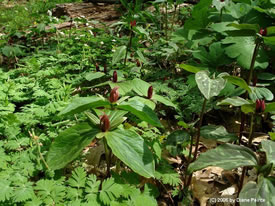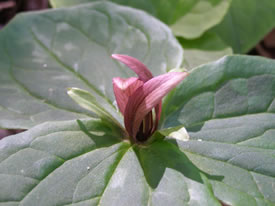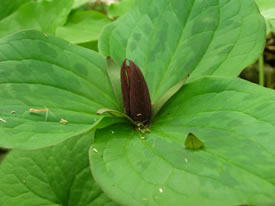Plant of the Week
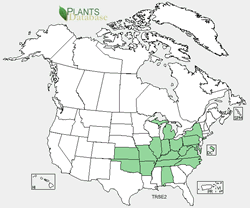 Trillium sessile range map. USDA PLANTS Database.
Trillium sessile range map. USDA PLANTS Database.
 In this grouping of Toadshade trilliums, note the variation in the coloration of the sepals and degree and intensity of mottling. Image with permission by Thomas Barnes.
In this grouping of Toadshade trilliums, note the variation in the coloration of the sepals and degree and intensity of mottling. Image with permission by Thomas Barnes.
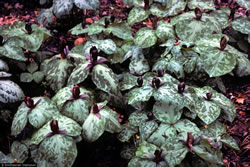 In this grouping of Toadshade trilliums, the sepals and petals are a very dark maroon and the leaves are strongly mottled with a silvery sheen to the lighter-green colored segments. Image by R. A. Howard, © Smithsonian Institution.
In this grouping of Toadshade trilliums, the sepals and petals are a very dark maroon and the leaves are strongly mottled with a silvery sheen to the lighter-green colored segments. Image by R. A. Howard, © Smithsonian Institution.
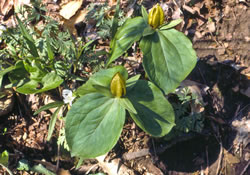 This pair of Toadshade trilliums lack the acanthocyanin maroon pigments resulting in entirely green sepals, very sparse mottling of the leaves and three yellowish-bronze petals. Image with permission by Larry Stritch.
This pair of Toadshade trilliums lack the acanthocyanin maroon pigments resulting in entirely green sepals, very sparse mottling of the leaves and three yellowish-bronze petals. Image with permission by Larry Stritch.
 The Toadshade trilliums, trilliums without a pedicel (flower stalk), are endemic to North America. The trilliums in Asia all belong to the pedicellate group. Image with permission by Charles Peirce.
The Toadshade trilliums, trilliums without a pedicel (flower stalk), are endemic to North America. The trilliums in Asia all belong to the pedicellate group. Image with permission by Charles Peirce.
Toadshade (Trillium sessile)
By Larry Stritch
Toadshade is an herbaceous, long-lived, woodland perennial wildflower with a broad distribution the central United States, from eastern Kansas and Oklahoma through the upper south and lower Midwest to New York and south to North Carolina.
“Trillium” is from the Latin “tri” referring to the flower parts occurring in threes, and “llium” from the Latin “liliaceous” referring to the funnel-shaped flower. “Sessile” is from the Latin “sessil”, for sessile, stalkless, which refers to the flower having no pedicel.
Trillium sessile has a short, thick rhizome from which a sheath (cataphyll) enclosed scape (stalk of the inflorescence) emerges from the ground to10 to 30 cm tall with a single, sessile, terminal flower. Leaves (actually bracts) are three, green, often mottled, sessile, oval, rounded, apiculate, base rounded and sessile, 4 to 10 cm long , 2 to 8 cm wide. Flowers are erect, sessile; petals three, dark maroon, brownish-maroon, green, yellow, bronze, erect to inwardly recurved, oblanceolate to oblong, 1.5 to 4 cm long. Sepals are three, green, occasionally streaked with maroon to a dark, greenish maroon, spreading, 1.5 to 4 cm long. The fruit is a dark greenish-purple, six-sided berry.
Trillium sessile flowers from early to late spring, depending on latitude. The species occurs in a range of habitats in rich deciduous woodlands often calcareous, floodplains and riverbanks; occasionally found in higher elevation dry, calcareous woods.
For More Information
- PLANTS Profile - Trillium sessile, toadshade
- Case, F. W. and R. B. Case. 1997. Trilliums. 284 pp. Timber Press. Portland, Oregon.
- Jacobs, D. L. and Jacobs R. L. 1997. Trilliums in Woodland and Garden: American Treasures. 152 pp. Eco-Gardens. Decatur, Georgia.
- Patrick, T. 2007. Trilliums of Georgia. Tipularia 22: 3-22. Georgia Botanical Society.
- Frett, J. 2007. Trilliums at Mt. Cuba Center: A Visitor’s Guide. 75 pp. Mt. Cuba Center, Inc. Greenville, Delaware.


